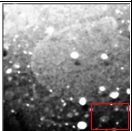Perbandingan Metode Median Filtering dengan CLAHE dalam Mengidentifikasi Koloni Bakteri
Abstract
Abstract— The exact estimation of the number of colonies or Colony Forming Units (CFUs) is frequently used in microbiology research, particularly in the field of bacteria. The number of colonies that develop per gram or milliliter of sample is estimated by multiplying the number of plates, the dilution factor, and the volume used [1]. Counting the number of bacterial colonies can be used to determine a bacterium's growth rate. The cup count method is commonly used to accomplish this manually. An instrument called a colony counter can help with colony counting utilizing the cup count method. This technology works by using a pen connected to a counter to mark the colonies that have been counted. However, because the colony size is tiny and the number of colonies counted is huge, this can lead to inaccuracies, and the same difficulties can happen with manual colony computations. Digital image processing technology has been extensively developed for use in a variety of fields. Researchers had previously undertaken a similar study that attempted to count bacterial colonies and had a 94 percent accuracy rate, but some colonies were not spotted because they were filtered during preprocessing, so they looked into it further.
Keywords—Bacteria Colony, Image Processing, Preprocessing,
Downloads
References
[2] G. A. Nai et al., “Fractal dimension analysis: A new tool for analyzing colony-forming units,” MethodsX, vol. 8, p. 101228, 2021, doi: 10.1016/j.mex.2021.101228.
[3] S. Khan, Farhan M; Gupta, Rajiv; Sekhri, “Automated Bacteria Colony Counting on Agar Plates Using Machine Learning,” J. Environ. Eng., vol. 147, no. 12, 2021, [Online]. Available: https://ascelibrary.org/doi/abs/10.1061/%28ASCE%29EE.1943-7870.0001948.
[4] T. Naets, M. Huijsmans, P. Smyth, L. Sorber, and G. de Lannoy, “A Mask R-CNN approach to counting bacterial Colony Forming Units in pharmaceutical development,” pp. 1–9, 2021, [Online]. Available: http://arxiv.org/abs/2103.05337.
[5] S. Badieyan et al., “Detection and Discrimination of Bacterial Colonies with Mueller Matrix Imaging,” Sci. Rep., vol. 8, no. 1, pp. 1–10, 2018, doi: 10.1038/s41598-018-29059-5.
[6] G. Zhu, B. Yan, M. Xing, and C. Tian, “Automated counting of bacterial colonies on agar plates based on images captured at near-infrared light,” J. Microbiol. Methods, vol. 153, pp. 66–73, 2018, doi: https://doi.org/10.1016/j.mimet.2018.09.004.
[7] N. Dupont-Bloch, “Advanced image processing,” Shoot Moon, no. February, pp. 219–240, 2016, doi: 10.1017/cbo9781316392843.009.
[8] X. Wang, T. Chen, D. Li, and S. Yu, “Processing Methods for Digital Image Data Based on the Geographic Information System,” Complexity, vol. 2021, p. 2319314, 2021, doi: 10.1155/2021/2319314.
[9] L. He, X. Ren, Q. Gao, X. Zhao, B. Yao, and Y. Chao, “The connected -component labeling problem: A review of state-of-the-art algorithms,” Pattern Recognit., vol. 70, pp. 25–43, 2017, doi: 10.1016/j.patcog.2017.04.018.
[10] P. Kaler, “Study of Grayscale image in Image processing,” Int. J. Recent Innov. Trends Comput. Commun., no. November, pp. 309–311, 2016.
[11] G. F. C. Campos, S. M. Mastelini, G. J. Aguiar, R. G. Mantovani, L. F. de Melo, and S. Barbon, “Machine learning hyperparameter selection for Contrast Limited Adaptive Histogram Equalization,” Eurasip J. Image Video Process., vol. 2019, no. 1, 2019, doi: 10.1186/s13640-019-0445-4.
[12] V. G. Rangarajan, Effectiveness of Contrast Limited Adaptive Histogram Equalization (CLAHE) on multispectral satellite imagery. 2016.
[13] J. Ma, X. Fan, S. X. Yang, X. Zhang, and X. Zhu, “Contrast Limited Adaptive Histogram Equalization-Based Fusion in YIQ and HSI Color Spaces for Underwater Image Enhancement,” Int. J. Pattern Recognit. Artif. Intell., vol. 32, no. 7, pp. 1–27, 2018, doi: 10.1142/S0218001418540186.
[14] S. Villar, S. Torcida, and G. Acosta, “Median Filtering: A New Insight,” J. Math. Imaging Vis., vol. 58, pp. 1–17, May 2017, doi: 10.1007/s10851-016-0694-0.
[15] A. Shah et al., “Comparative analysis of median filter and its variants for removal of impulse noise from gray scale images,” J. King Saud Univ. - Comput. Inf. Sci., no. xxxx, 2020, doi: 10.1016/j.jksuci.2020.03.007.
[16] Nilasari.Ni Ketut Novia, Supianto.Ahmad Afif, and Suprapto, , 2014,I dentifikasi Jumlah Koloni Bakteri dengan Metode Improved Counting Morphology. Skripsi. Program Studi Teknik Informatika.Universitas Brawijaya. Malang.
[17] A. Fadjeri, A. Setyanto, and M. P. Kurniawan, “Pengolahan Citra Digital Untuk Menghitung Ekstrasi Ciri Greenbean Kopi Robusta Dan Arabika (Studi Kasus: Kopi Temanggung),” J. Teknol. Inf. dan Komun., vol. 8, no. 1, pp. 8–13, 2020, doi: 10.30646/tikomsin.v8i1.462.
[18] A. Shah et al., “Comparative analysis of median filter and its variants for removal of impulse noise from gray scale images,” J. King Saud Univ. - Comput. Inf. Sci., no. xxxx, 2020, doi: 10.1016/j.jksuci.2020.03.007.
[19] N. L. K. Sari, M. Oktavianti, and S. Samsun, “Analisis Karakter Segmen Abnormal pada Citra Mamografi dengan Menggunakan Berbagai Metode Preprocessing Citra,” J. Ilm. Giga, vol. 22, no. 1, p. 1, 2020, doi: 10.47313/jig.v22i1.737.
[20] G. F. C. Campos, S. M. Mastelini, G. J. Aguiar, R. G. Mantovani, L. F. de Melo, and S. Barbon, “Machine learning hyperparameter selection for Contrast Limited Adaptive Histogram Equalization,” Eurasip J. Image Video Process., vol. 2019, no. 1, 2019, doi: 10.1186/s13640-019-0445-4.


This work is licensed under a Creative Commons Attribution-NonCommercial-NoDerivatives 4.0 International License.

This work is licensed under a Creative Commons Attribution 4.0 International License




